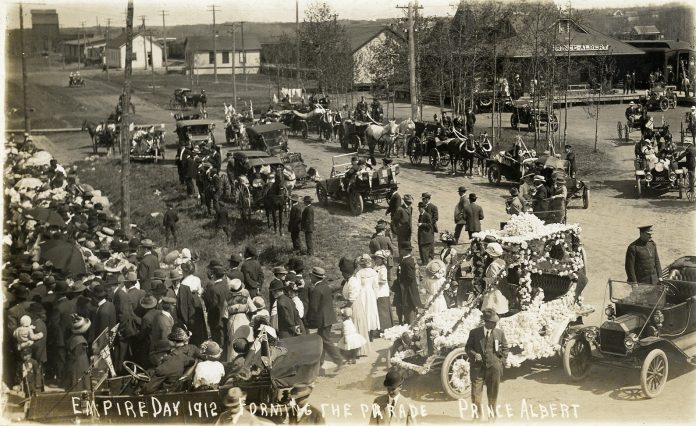
Fred Payton
Prince Albert Historical Society
It was an honour for me to be invited to attend and speak at last week’s unveiling of the Provincial Heritage plaque at the former Immigration Hall. The building had been used by the government in the early twentieth century to provide shelter and services for the wave of new immigrants arriving in northern Saskatchewan. Today, it proudly houses the YWCA Prince Albert Our House Supportive Recovery Centre, which shelters women and assists individuals of all genders struggling with mental health concerns and addictions.
Although originally designated as a heritage site by the provincial government in 2018, the unveiling of the plaque was delayed as a result of the COVID-19 pandemic.
Designed by the federal Department of Public Works under the supervision of the Dominion Architect, Thomas Fuller, it reflects the architectural traditions of the time as evident in the simplified classical design with yellow brick accented with Tyndal stone, muted brick detailing, small cornices, and brick pilasters framing the doorway. The architectural elements include symmetry of the front façade with a central flagpole, decorative brick arch work around the windows on the front façade, and a prominent front entrance pavilion.
Immigration Hall was built and opened in 1929, replacing a temporary structure located on the south-east corner of 15th Street and 1st Avenue East. The existent structure was one of the last such halls built in western Canada, and ours is the last remaining such structure in the province.
Of importance historically, the Immigration Hall is associated with the wave of immigrants entering Saskatchewan in the late 19th and early 20th centuries. Built more as a dormitory than as an administrative office, it was intended to serve as accommodation for immigrants on their arrival in Prince Albert, prior to settling in the area.
It is, I think, noteworthy that the federal government had a policy in the 19th century to encourage immigration in areas already served by rail transportation. As a result, since the route of the intercontinental railway was diverted from its expected northern location, immigration to areas in what is now southern Saskatchewan was encouraged to a greater extent than to the area around Prince Albert. The federal government therefore left this community without an Immigration agent until 1892. By 1903, that agent had become responsible for homestead settlements as far east as Tisdale, south to Saskatoon, and to what is now Blaine Lake in the west.
Homestead entries for the local agent rose from 303 in 1900 to 2, 894 in 1903. In the first six months of 1904, entries fell off considerably due to the “great and unusual difficulties affecting the Canadian Northern branch line”, according to the local agent. This made for a much less favourable season for immigration than had been expected.
Between 1905 and 1910, a yearly average of 1,700 homesteads were claimed through the Prince Albert agency. One of the most popular districts was the Shell Valley, especially after 1909 with the completion of the railway bridge and the beginning of the Canadian Northern line to the Battlefords.
In 1919, 921 homesteads and 1,254 soldier settlement grants were recorded by the local Immigration agent. Although most of these were returning soldiers and European immigrants, there was also a number of migrants from the drought stricken south.
Between 1924 and 1929, a further heavy influx of immigrants arrived, with 1,732 homestead claims made in 1926 alone. It is understandable that Prince Albert’s Member of Parliament, William Lyon MacKenzie King, recognised the need to build a more permanent structure. However, as we know, shortly after the opening of the Immigration Hall, the number of immigrants was drastically reduced, mostly due to the collapse of the world economy. This situation brought about a downturn in the demand for such agrarian products as wheat (something for which our local farmers were known), and was further exacerbated by the drought conditions in western Canada.
Although immigration was severely curtailed during the 1930s and 1940s, the Immigration Hall still served as the office for the Immigration department until at least 1941. It also housed other federal government offices and agencies. As World War II ended, and with members of Canada’s military returning home, the building was once more pressed into service as a dormitory. As many as three trains a day arrived at the railway station across 15th Street, and those requiring overnight accommodation on their first night back in northern Saskatchewan were accommodated in what became known as the Beaver Lodge. Beaver Lodge was opened officially on May 24th, 1945, but had been in operation for some time before that date. By September 1947, more than 1,600 men had used the three rooms on the ground floor where they could wash off the grime of travel and sleep until they were able to access other accommodation. (Women returning who needed such temporary accommodation were housed in the YWCA building which, at that time, was located on the north-east corner of 1st Avenue and 14th Street West.)
By 1950, the building’s major tenant was Indian Health Services. They shared tenancy for a year in 1957 with Citizenship and Immigration – Indian Affairs branch. In 1958, tenancy was shared between Indian Health Services and the Carlton Indian Agency. In subsequent years, various federal government departments, including the Department of Fisheries (later Fisheries and Oceans), the Farm Labour Pool, and the Department of the Environment – Forestry shared space in the building with Indian Health Services and the Carlton Indian Agency. The City of Prince Albert even leased space there in the late 1980s for its Public Works department.
The building sat vacant throughout the 1990s and early 2000’s until it was purchased by the YWCA. Once again it began to serve the needs of Prince Albert and area, and it continues to meet the needs of people as they make one more stop on their journey through life in northern Saskatchewan.

